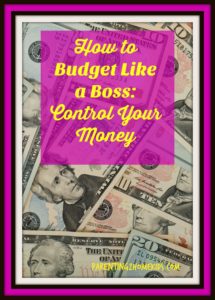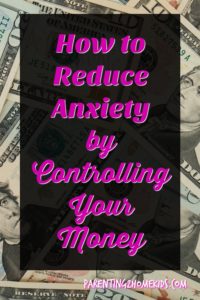
You can learn to control your money.
Does your money run out before the month runs out? Do you panic at the thought of making a budget. Lack of money is often one of the biggest fears when you move from a two-income household to a one-income household. Finances are a common marital stress, so sometimes after a divorce you will find there is actually more money for your own priorities. Commonly, there is a saver and a spender in a relationship. If you are the saver, life may actually get easier. If you are the spender, consider this an opportunity to learn and grow because there is less to spend.
When you are stressed about money, you need to learn budgeting skills. The actual math part of this skill is quite easy, probably about 5th-grade level, so take heart. You can do this. There are a few simple steps, but they are honestly easier said then done.
Step One, Mindset
First, wrap your mind around the idea that it is easier to live by a budget than not live by a budget. Without a budget, money often runs out before the month runs out. Unexpected expenses, like your car needing tires or the kids needing another ten or twenty dollars for their activities, become crises. (I don’t know about you, but sometimes I feel like an ATM when it comes to school activities and fundraisers.) Once you admit that following a budget is less painful than running out of money, you are ready to proceed.
Step Two, Get a Budget Sheet
Choose a budget sheet. Two of my favorites are Our Modern Homesteads’ Budget Worksheets & Dave Ramsey’s, which you can download here. I really like that he has suggested percentages for each category so you have a benchmark to start with. If you hate the idea of budgeting and you are starting to panic, take a deep breath. You’ve got this. Here is an Amazon affiliate link to some of my favorite Dave Ramsey resources.
Now you are ready to fill it out. Start with what you spend for housing, utilities, the car payment, and insurance. Those are easy because you can just look them up in your checkbook. Next, fill in what you think you spend on food, medical needs, and other transportation costs. If you don’t know, give it your best guess. If you have debt, start with budgeting the minimum payment. Now you have your needs covered: housing, food, health, and transportation.
Step Three, Wants vs. Needs
Take out your calendar and schedule an hour to do the next step. If you feel you can continue, subtract your needs from your income. Now you know what you have left for wants. Usually it is more money than you thought.
We all have wants and life is more fun with luxuries. It also makes following a budget easier. If you get child support, it is best that that goes to your wants and not your needs. Your spouse may change jobs without any notice to you, get fired, laid off or even quit. You may not be in the know about this coming. Some parents after a divorce will do what they can to avoid paying child support. Hopefully this will not happen to you, but it is best to be prepared and able to cover the necessities without child support.
I suggest that you budget for personal money even if it is a very small amount. We all need a little mad money. Next, look at your wants and your debt. The goal is to have zero debt. Dave Ramsey writes extensively about this, and if you haven’t read his books or taken a Financial Peace University class, I highly recommend them. He has a baby step system that will move you from debt to financial security and freedom.

When your money is out of control your anxiety skyrockets.
Step Four, Savings
Dave Ramsey’s first baby step is to have a $1,000 emergency fund. This may sound overwhelming, but if you save $84 a month, you will have $1,000 at the end of the year. Why do you need an emergency fund? You need it because there are little emergencies that come up. Maybe the element on your stove goes out, your car needs to go to the shop, or your kids go through a growth spurt and don’t fit in any of their jeans. $1,000 will cover most unexpected expenses. A $1,000 emergency fund does wonders to reduce your anxiety, so work toward it and you will be amazed by how much calmer you feel.
Step Five, Evaluate
Now that you have a budget, get your schedule out and set a one-hour appointment with yourself in about three weeks. This is the time you will review your budget, evaluate how it works for you, and revise it if necessary.
Do you have a budget and follow it? Why or why not?
Postscript: Eating out is a drain on a family budget. Over the years, I developed a plan for how to get healthy meals on the table fast. Enter your e-mail address below and I will send you that plan.
You might also be interested in:
5 Steps to Work-Life Balance, where you can get an overview of how to balance all of the demands of life, work, and parenting.
Work-Life Balance: Priorities, where I compare budgeting time to budgeting money.
Why Family Meals are the Best 40-Minute Investment, which shows that family meals are doable and worth the effort.

Hi, I’m Tamara the creator of Empowered Single Moms, a single mom, a Licensed Clinical Social Worker (LICSW) and the author of Thriving a Single Mom’s Guide to a Happy, Positive Life and Thriving a Single Mom Journal. I have a solo private psychotherapy practice where I treat anxiety, depression, and relationship issues.
As a member of the Empowered Single Moms community, I believe you can stop carrying the weight of the world alone and build a life you love. Join my mailing list and get 5 Keys to Single Mom Success.

Thanks for all the great tips. my dad enjoys listening to dave ramsey on the radio. he says he has sound advice. I’m here from the Productive Moms Link-Up.
Brenda, Dave Ramsey has great resources. Thanks for stopping by.
Thanks Productive Mompreneuer!